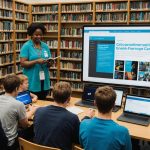Overview of Digital Literacy in UK Libraries
Digital literacy is the ability to find, evaluate, and use digital information effectively. It is increasingly vital in today’s society, where many aspects of life, from education to employment, rely on digital competencies. Libraries in the UK play a significant role in fostering these skills through various programs and initiatives.
In the current landscape, many UK libraries have made strides in promoting digital literacy. These institutions offer workshops, courses, and access to technology, aiming to equip community members with the skills needed to navigate the digital world. As a hub of community engagement, libraries are uniquely positioned to reach diverse populations and bridge the digital divide.
Also to see : Revolutionizing uk supply chains: navigating the benefits and challenges of blockchain implementation
Statistics highlight the tangible benefits of digital literacy and community engagement. For instance, individuals with strong digital skills are more likely to find employment and engage with learning opportunities. Moreover, communities with higher rates of digital literacy experience enhanced social cohesion and economic growth.
Despite these efforts, there are still challenges to overcome. Not all libraries have equal resources and some communities may require more tailored approaches to effectively engage with digital skills programming. UK libraries continue to adapt and innovate, ensuring that digital literacy becomes a widespread and inclusive resource for their communities.
In parallel : Transforming finances: the game-changing impact of digital transformation on uk financial services
Strategies for Implementing Digital Literacy Programs
Launching digital literacy initiatives requires a comprehensive approach to engage and educate communities. To effectively establish these programs, several strategies are pivotal.
Assessing Community Needs
Understanding the specific needs of your community is crucial before implementing digital literacy programs. Conducting a community needs assessment uncovers gaps and preferences in digital skills. Tools such as surveys, focus groups, and interviews are essential methods for gathering this feedback. Identifying target demographics through these techniques helps tailor programs to the unique requirements of different groups.
Developing Program Content
Creating engaging and comprehensive content is key to successful digital literacy initiatives. Best practices include incorporating diverse learning styles and formats, ensuring inclusivity and accessibility. Consider examples from successful UK libraries, which offer a mix of interactive workshops, online resources, and hands-on sessions. This variety caters to different preferences and enhances participant engagement.
Training Librarians and Volunteers
Librarians play a vital role in delivering these initiatives. Preparing them for digital literacy instruction involves providing robust training and ongoing professional development. Collaborative partnerships with local experts and organizations can offer additional resources and expertise. This not only strengthens the program but also fosters a community-driven approach to digital literacy, making it sustainable and impactful.
Case Studies of Successful Digital Literacy Programs
Several successful programs have emerged within UK libraries, demonstrating significant progress in enhancing digital literacy. One standout example is the initiative by the Manchester Central Library, which leveraged technology to bridge the digital divide. This program profoundly impacted the local community, providing residents with the skills to navigate the digital landscape confidently.
The impact of these initiatives can be measured through various measurable outcomes. Such programs have shown remarkable improvements in participants’ digital skills, with many reporting increased confidence in using technology for everyday tasks. Feedback from the community has been overwhelmingly positive, citing increased accessibility to digital resources as a major benefit.
One particularly successful initiative focused on empowering older adults, underscoring the program’s community impact by enhancing intergenerational interactions. The key takeaway from Manchester’s success is the importance of tailoring programs to meet community-specific needs and fostering an environment of inclusivity and continuous learning.
Another critical lesson from these case studies is the value of engaging community feedback. Libraries consistently adapt their approach based on participants’ responses, leading to more effective and sustainable solutions. These programs’ success serves as a blueprint for future digital literacy efforts, with potential for even broader positive outcomes.
Tools and Resources for Libraries
Libraries have access to a plethora of digital tools and resources to enhance their programs and outreach.
Online Platforms for Digital Literacy
Digital literacy is crucial in today’s tech-driven world. Libraries can leverage online platforms to offer digital literacy programs. Popular platforms like Coursera, Codecademy, and Khan Academy provide free or low-cost courses. These digital tools offer diverse features, such as interactive learning, analytics, and accessibility support, catering to different community needs. When selecting platforms, libraries should consider the platform’s user-friendliness and community fit. For instance, a platform with robust language support may suit a multicultural community.
Funding and Grants
Securing funding is vital for sustaining library programs. Libraries can explore various funding sources, such as government grants, philanthropic organizations, and private donors. Tips for successful grant proposals include: clearly defining program objectives, demonstrating community impact, and detailing budget requirements. Libraries like the Brooklyn Public Library have successfully secured funding, enabling the expansion of their digital literacy offerings.
Networking and Collaborations
Collaboration with local organizations, businesses, and larger networks like library consortia can enhance a library’s resources and effectiveness. Partnerships can provide support, expertise, and additional resources. Effective strategies include organizing joint events and sharing information and tools. Engaging in larger networks also opens doors for broader community engagement and support.
Measuring and Evaluating Program Success
To effectively gauge the success of a digital literacy program, it is crucial to identify and utilise key performance indicators (KPIs). These indicators act as measurable values that demonstrate how effectively the program is achieving its objectives. Common KPIs include the number of participants, skills acquisition rates, and participant satisfaction levels.
Metrics serve as a cornerstone in the evaluation process. They offer tangible evidence of progress and can be collected through pre- and post-assessment tests, surveys, and feedback forms. This data provides a solid foundation for understanding the program’s impact and shaping future initiatives.
Incorporating the community is another vital aspect of program evaluation. Engagement can be ensured by sharing results with both community members and stakeholders. This transparency not only builds trust but also inspires continued support and participation. Reports, open forums, and community newsletters are effective methods for communicating results.
Moreover, community engagement can offer qualitative insights that quantitative data may miss. By fostering an open dialogue, program coordinators can gain feedback that highlights areas for improvement, ensuring the program’s continuous evolution and relevance.
In conclusion, by setting clear KPIs, continuously collecting and analyzing metrics, and maintaining strong community engagement, programs can achieve an accurate and dynamic evaluation process.











